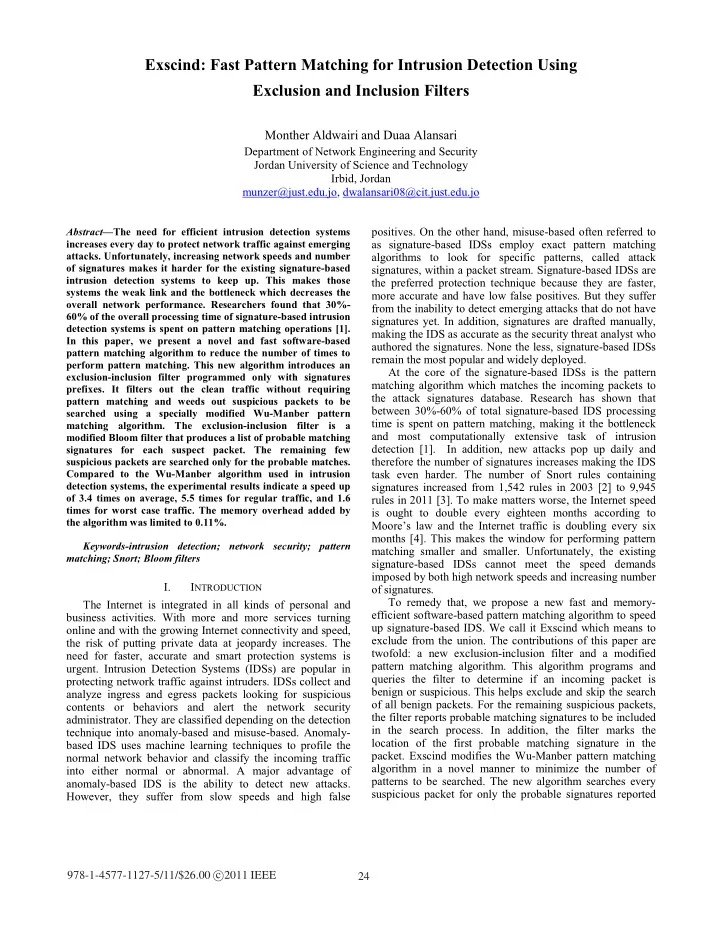

Exscind: Fast Pattern Matching for Intrusion Detection Using Exclusion and Inclusion Filters Monther Aldwairi and Duaa Alansari Department of Network Engineering and Security Jordan University of Science and Technology Irbid, Jordan munzer@just.edu.jo, dwalansari08@cit.just.edu.jo Abstract —The need for efficient intrusion detection systems positives. On the other hand, misuse-based often referred to as signature-based IDSs employ exact pattern matching increases every day to protect network traffic against emerging attacks. Unfortunately, increasing network speeds and number algorithms to look for specific patterns, called attack of signatures makes it harder for the existing signature-based signatures, within a packet stream. Signature-based IDSs are intrusion detection systems to keep up. This makes those the preferred protection technique because they are faster, systems the weak link and the bottleneck which decreases the more accurate and have low false positives. But they suffer overall network performance. Researchers found that 30%- from the inability to detect emerging attacks that do not have 60% of the overall processing time of signature-based intrusion signatures yet. In addition, signatures are drafted manually, detection systems is spent on pattern matching operations [1]. making the IDS as accurate as the security threat analyst who In this paper, we present a novel and fast software-based authored the signatures. None the less, signature-based IDSs pattern matching algorithm to reduce the number of times to remain the most popular and widely deployed. perform pattern matching. This new algorithm introduces an At the core of the signature-based IDSs is the pattern exclusion-inclusion filter programmed only with signatures matching algorithm which matches the incoming packets to prefixes. It filters out the clean traffic without requiring the attack signatures database. Research has shown that pattern matching and weeds out suspicious packets to be between 30%-60% of total signature-based IDS processing searched using a specially modified Wu-Manber pattern time is spent on pattern matching, making it the bottleneck matching algorithm. The exclusion-inclusion filter is a and most computationally extensive task of intrusion modified Bloom filter that produces a list of probable matching detection [1]. In addition, new attacks pop up daily and signatures for each suspect packet. The remaining few therefore the number of signatures increases making the IDS suspicious packets are searched only for the probable matches. Compared to the Wu-Manber algorithm used in intrusion task even harder. The number of Snort rules containing detection systems, the experimental results indicate a speed up signatures increased from 1,542 rules in 2003 [2] to 9,945 of 3.4 times on average, 5.5 times for regular traffic, and 1.6 rules in 2011 [3]. To make matters worse, the Internet speed times for worst case traffic. The memory overhead added by is ought to double every eighteen months according to the algorithm was limited to 0.11%. Moore’s law and the Internet traffic is doubling every six months [4]. This makes the window for performing pattern Keywords-intrusion detection; network security; pattern matching smaller and smaller. Unfortunately, the existing matching; Snort; Bloom filters signature-based IDSs cannot meet the speed demands imposed by both high network speeds and increasing number I. I NTRODUCTION of signatures. To remedy that, we propose a new fast and memory- The Internet is integrated in all kinds of personal and efficient software-based pattern matching algorithm to speed business activities. With more and more services turning up signature-based IDS. We call it Exscind which means to online and with the growing Internet connectivity and speed, exclude from the union. The contributions of this paper are the risk of putting private data at jeopardy increases. The twofold: a new exclusion-inclusion filter and a modified need for faster, accurate and smart protection systems is pattern matching algorithm. This algorithm programs and urgent. Intrusion Detection Systems (IDSs) are popular in queries the filter to determine if an incoming packet is protecting network traffic against intruders. IDSs collect and benign or suspicious. This helps exclude and skip the search analyze ingress and egress packets looking for suspicious of all benign packets. For the remaining suspicious packets, contents or behaviors and alert the network security the filter reports probable matching signatures to be included administrator. They are classified depending on the detection in the search process. In addition, the filter marks the technique into anomaly-based and misuse-based. Anomaly- location of the first probable matching signature in the based IDS uses machine learning techniques to profile the packet. Exscind modifies the Wu-Manber pattern matching normal network behavior and classify the incoming traffic algorithm in a novel manner to minimize the number of into either normal or abnormal. A major advantage of patterns to be searched. The new algorithm searches every anomaly-based IDS is the ability to detect new attacks. suspicious packet for only the probable signatures reported However, they suffer from slow speeds and high false 978-1-4577-1127-5/11/$26.00 c � 2011 IEEE 24
Recommend
More recommend